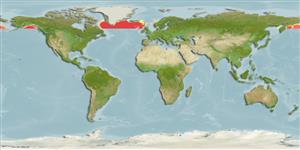Environment: milieu / climate zone / depth range / distribution range
Ekologi
marina batypelagisk; djupintervall 500 - 7625 m (Ref. 58426), usually 1200 - 1400 m (Ref. 559). Deep-water; 67°N - 56°N, 180°W - 180°E
Circumglobal: In tropical to temperate waters. Eastern Pacific: ranges from northern California to Peru (Ref. 35600).
Size / Vikt / Age
Maturity: Lm ? range ? - ? cm
Max length : 100.0 cm TL hane/ej könsbestämd; (Ref. 27000); common length : 55.0 cm NG hane/ej könsbestämd; (Ref. 5755)
Taggstrålar i ryggfenan (totalt): 0; Taggstrålar i analfenan 0. Mouth greatly enlarged by a backward extension of jaws, gape comprising half or more of preanal length; buccal cavity greatly distensible. Tail attenuated and ending in an expanded, luminous caudal organ. Caudal fin absent; scales absent; lateral line without pores, instead with groups of elevated tubules.
Meso- to abyssopelagic (Ref. 58302) and bathypelagic (Ref. 58426). Adults feed mainly on crustaceans, but also take fishes, cephalopods, and other invertebrates (Ref. 2850, 11041). Oviparous, planktonic eggs hatch into planktonic leptocephalus larvae (Ref. 6719, 35600). Degenerative changes in males and females suggest semelparity (Ref. 35600).
Life cycle and mating behavior
Könsmognad | Reproduktion | Lek | Ägg | Fecundity | Larver
Oviparous (Ref. 35600). Degenerative changes in males and females suggest semelparity (Ref. 35600). Egg cells within each of the gonads have the same developmental stage (monocyclic ovaries) suggesting only one spawning during its lifetime or periodic spawning (Ref. 36055).
Nielsen, J.G. and E. Bertelsen, 1990. Eurypharyngidae. p. 206. In J.C. Quero, J.C. Hureau, C. Karrer, A. Post and L. Saldanha (eds.) Check-list of the fishes of the eastern tropical Atlantic (CLOFETA). JNICT, Lisbon; SEI, Paris; and UNESCO, Paris. Vol. 1. (Ref. 4457)
IUCN Red List Status (Ref. 130435)
Threat to humans
Harmless
Human uses
Fiskeri: saknar intresse
Verktyg
Special reports
Download XML
Internet-källor
Estimates based on models
Preferred temperature (Ref.
123201): 2.3 - 5.5, mean 3.6 °C (based on 890 cells).
Phylogenetic diversity index (Ref.
82804): PD
50 = 1.5000 [Uniqueness, from 0.5 = low to 2.0 = high].
Bayesian length-weight: a=0.00102 (0.00046 - 0.00225), b=3.06 (2.88 - 3.24), in cm total length, based on all LWR estimates for this body shape (Ref.
93245).
Trofisk nivå (Ref.
69278): 4.1 ±0.57 se; based on food items.
Resiliens (Ref.
120179): Mycket låg, lägsta populationsfördubblingstid mer än 14 år (Assuming semelparity with tm>10).
Fishing Vulnerability (Ref.
59153): High vulnerability (60 of 100).
Nutrients (Ref.
124155): Calcium = 15.6 [4.0, 64.6] mg/100g; Iron = 0.408 [0.125, 1.243] mg/100g; Protein = 2.94 [0.00, 6.86] %; Omega3 = 0.192 [0.063, 0.599] g/100g; Selenium = 18.7 [6.0, 72.0] μg/100g; VitaminA = 28.8 [3.8, 214.8] μg/100g; Zinc = 0.453 [0.206, 1.092] mg/100g (wet weight);
